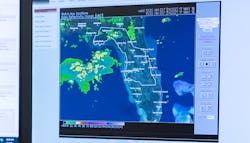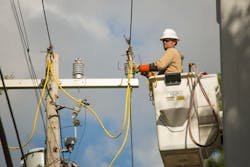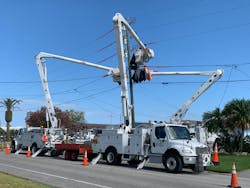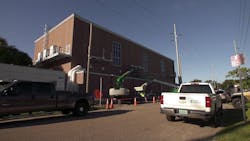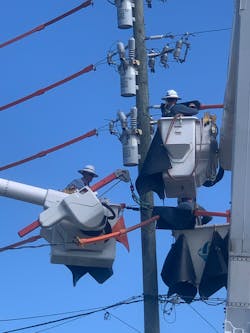Duke Energy is on pace to reduce its SAIDI by 20 minutes since 2018. This is not a simple thing to do when you are serving nearly 1.9 million customers in a region that experiences the most thunderstorms in the United States. To make this much progress in not much time, the utility implemented a multi-part strategy involving sophisticated sectionalizing of its distribution system, a restructuring of territory management, better repair process discipline, storm hardening, substation optimization and next-generation power grid planning.
Duke Energy’s power reliability team wanted to break out of the usual habits of a patchwork of repairs and the classic pole and cable replacement method of maintenance. Instead, the utility would attack entire sections of the grid — with a focus on those sections that are most demanding on labor and capital resources.
Duke Energy matured its strategy and approach to how it analyzes, plans and executes work around the substation. The utility refers to this as substation optimization, where the utility identified an entire area served by one substation and began hardening and improving assets, including feeders and circuits. The goal is not just better reliability and performance, but resiliency after storms. This is a way for Duke to focus efforts instead of being programmatic and spread out.
Focus on the Substation
An important concept underlying substation optimization is the focus on the substation as the “center of the universe.” This involves making the appropriate investments into each of the feeders coming out of a particular substation. The strategy targets substations based on factors such as asset type, reliability improvement potential and capacity. Potential future use of distributed generation assets and electric vehicle saturation are also factors.
Duke Energy asks the question, what should be done in an area served by a particular substation? The answer usually involves installing self-optimizing grid upgrades, storm hardening improvements with feeder hardening, lateral hardening either underground or on larger overhead poles with shorter spans. Another option might be replacing first-stage protective devices with auto-reclosing devices.
The substation optimization program is already underway, with Florida entering year one of the plan in 2021. This phase consisted mostly of planning, with twelve Florida substations chosen to undergo upgrades in 2022, with more substations entering the planning and design phase in 2023. The substation optimization program is still in its infancy, so it cannot be cited as a reason for the reliability improvements the utility has already measured but upgrading a dozen or so substations and working toward 25 substation upgrades each year is the utility’s planned way forward and a path toward future reliability scores year after year.
All available data about a particular substation must be considered. For example, even weather and climate data are part of the strategy. Targeting sections of the grid that have been historically impacted by major storm events might offer some low-hanging fruit in terms of improving service reliability. In 2019 the company also used Exacter predictive analytics and circuit assessments to provide additional intelligence for where to channel resources. Exacter may be used going forward to assure quality installations and to further identify substation candidates for improvement. One of the largest customer benefits over time will be fewer outages and quicker restoration schedules thanks to substation optimization.
By strategically prioritizing the portions of the grid that have been most severely damaged by storms or are just perennial poor performers because of an aging infrastructure, the utility can free up resources to improve and maintain larger swaths of the grid. Much of the constraint to reliability improvement lies in those circuits that demand more service time and capital improvement.
Few other parts of the nation have more thunderstorm activity than Florida. In the western half of the peninsula in a typical year, there are over 80 days with thunder and lightning. Central Florida’s frequency of summer thunderstorms equals that of the world’s maximum thunderstorm areas: Lake Victoria region of equatorial Africa and the middle of the Amazon basin. So weather is perhaps the greatest opportunity for reliability improvement on which to focus.
Achieving Reliability Gains
Deeper insights into circuit performance are important factors in Duke Energy’s recent reliability gains. A reorganization of power grid responsibilities and restructured service territories means Duke Energy’s four-section map is now a 12-section map, with each section having its own area director who is totally responsible for all aspects of their territory.
Now that there are 12 divisions, each with their own area director, there is someone responsible for reliability, customer satisfaction, response maintenance and capital improvements in those regions. This allows the utility to become more granular in its reliability measures as there is now more management intelligence in the command structure.
These leaders know their territories, where the pain points are, what technologies or tools can be helpful, and where to indicate to corporate for potential new capital investment.
Getting Disciplined
In addition to personnel and technology changes, Duke Energy is getting results from being disciplined in outage response time. Each field team and manager from each of the 12 sections needed to properly address feeder restoration, recloser restoration, overhead fuse restoration and underground fuse restoration.
In December 2018, reclosers in an outage-stricken area required 87 minutes to restore, but restoration time has since been cut by 12 minutes. In that same period, overhead fuse outages also saw a 12-minute improvement in restoration time.
The basic process on the ground by Duke Energy maintenance teams is now consistent and disciplined — designed to show continuous improvement. The mission is to put the feeders first and get on them quickly, using sectionalizing points and restoring them first instead of going off on a hunch and trying to find the source of an outage individually. Workers are encouraged to stick to the process.
With the utility’s newly assigned area directors, analytics and operations centers, Duke Energy gained visibility into the process. The outage mix will inevitably change over time, but the system can remain reliable on the factors operational teams can control, which includes response time. The discipline factor is keeping everyone in the loop on progress from the managers to the line workers doing the job, to central management teams.
Toward a Self-Healing Grid
From a technology and investment perspective Duke Energy Florida began connecting electronic reclosers across the grid in 2015 by devising what it called simple self-healing teams. This involves installing reclosers at the manual tie switch with communication between devices. When a fault occurred, Duke Energy could isolate and open up the midpoint, closing the recloser at the tie switch location and picking up the back half of the feeder from the back half of the adjacent circuit and vice versa. The approach is simple: Isolate and restore, and it has worked.
The next phase, which Duke Energy called the self-optimizing grid, began in 2018. It took the self-healing concept to the next level through further power grid sectionalizing. Before the transition to self-optimizing grid, a particular section might have around 2,000 customers, but now targets 400-customer segments. In this approach, Duke Energy targets installing electronic reclosers every 400 customers, 3 miles of line, or 2 MW of load.
When a fault occurs, grid operators can back-feed from multiple directions now that they can isolate and back-feed. This is not as simple as dividing of circuits and saturating the grid with reclosers. The utility also must be able to have connectivity and capacity. This requires creating new tie points. At this point, an intelligent network is created.
The result? Millions of customer minutes of interruption (CMI) saved through applying this technology. In 2020, Duke Energy saved 18.9 million CMI. In 2019, it saved 10.2 million CMI and another 13.7 million CMI were saved as of September 2021.
Improving Operations Centers
In grid operational centers, the data received by management is now structured to be “exception based.” This includes asking questions like “What has changed?” “What is unusual?” “What is the delta?” “What should we focus our attention on and discuss to make improvements?” This has resulted in improvements to outage response times and restoration, but also in our internal processes and managed improvements.
Every morning at the 8:30 Daily Operations Call, if there are outages above certain CMI or outage length, operators call review an “exception 035 report,” which is an outage management system (OMS) snapshot based on defined thresholds. The report includes information on outage duration, outage frequency and the number of customers affected. Anything over a set threshold triggers further action. Area directors talk to the line supervisor to find out what happened. Next come meetings on how to improve performance. These talks drive where capital improvement might happen in the areas that present the most frequent or severe issues.
The utility developed a hybrid mid-level command structure for the frequent thunderstorms that are common to Central Florida area. In this system, utility meteorologists and operation centers collaborate to evaluate storm risk and discuss where the most severe problems may take place in advance of the storm so the 12 operating areas can share and deploy resources accordingly. Again, this requires the discipline to have discussions early in the day and prepare for what is to come.
Duke Energy meteorologists have developed some predictive weather event simulations specifically for severe thunderstorms. These are a work in progress as weather patterns are difficult to track, but the utility’s methods are getting better with each new storm. An average Level 2 weather event, for example, is estimated to cause about of two SAIDI minutes, however some are more or less severe than anticipated.
Changing Needs for Power
Electricity users are more reliant on the product utilities sell than before, with so many working from home, or educating children at home. Utilities must ask whether they are making the right investments for customers who are relying on us more than ever before. Utility workers are keenly aware of the impact of lengthy outages to our customers.
Utilities can improve and deliver more reliable service by making sure decisions are always anchored in making investments that provide a more disaster-hardened system. For Duke Energy Florida, that means being extremely responsive to hurricanes and tropical storms and making sure that capital expenditures will be able to deliver quantifiable gains on these metrics.
Duke Energy wants to create a better customer experience, so it began studying data from customer feedback to address improvement opportunities. Duke Energy strives to create an environment for continuous improvement, which ultimately makes a better utility.
Barry Anderson is regional senior vice president, Customer Delivery, Florida, at Duke Energy. He is responsible for operations of the company’s electric distribution system including construction, maintenance, engineering and resource and project management. He joined Duke Energy in October 2018 to serve in his current role. He brings more than 35 years of experience in the energy field.
Brian Lloyd is general manager of Region Major Projects at Duke Energy. His job responsibilities are asset management, project development, project management, filing management and business integration. His background includes analyzing trends for distribution equipment at Progress Energy, now a part of Duke Energy.
For More Information
Exacter, Inc. | www.exacterinc.com

